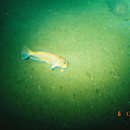mk
имиња во трошки


жапан амадайы (Branchiostegus japonicus) - деңизде жашоочу алабуга балыктарынын бир түрү.
Branchiostegus japonicus, the horsehead tilefish, Japanese horsehead tilefish, red amadai or the red tilefish, is a species of marine ray-finned fish, a tilefish belonging to the family Malacanthidae. It is native to the western Pacific Ocean.
Branchiostegus japonicus has an elongated, fusiform body with slightly oblique jaws which reach back as far as the front third of the pupil. Overall the body is pinkish-red, overlain by a golden tint and with underlying pale yellow blotches. There are also a number of irregular reddish blotches on the back in the middle of the body, these give the impression of the mucus coating having been locally stripped away to show the underlying golden-yellow hue. The fold to the front of the dorsal fin is dark. Unlike some other species in the genus Branchiostegus, there are no silvery bars below the eye but there is a large triangular patch of silvery-white below the eye, which is characteristic, and a smaller similarly shaped white patch is sometimes present on the upper edge of the gill cover. The caudal fin has 5 or 6 vivid yellow stripes with the middle stripes being more obvious than this on the upper and lower caudal fin lobes.[3] This species grows to a length of 46 centimetres (18 in) total length though most are around 35 centimetres (14 in). The greatest recorded weight for this species is 1.3 kilograms (2.9 lb).[2]
Branchiostegus japonicus is found in the Western Pacific Ocean. Here it occurs from Honshu to Kyushu in Japan and in the East China Sea. Its range extends from the coast of China to southern Vietnam and into the waters of the Philippines. It has also been reported from the Arafura Sea but there is a lack of recent information confirming these reports.[1]
Branchiostegus japonicus is found in association with burrows created in soft substrates made up of sand and mud or shell, sand and mud at depths of 30 to 265 m (98 to 869 ft). It is frequently caught at depths of 80 to 200 m (260 to 660 ft) in the East China and Yellow Seas. They spawn twice a year, in July and October, with larvae first appearing in the Sado Straits of the Sea of Japan in October.[3] The fishes excavate their burrows which they used to escape from predators and as nocturnal shelters.[1] They are pelagic spawners, the eggs float in the water column as a mass encased in mucus.[4]
Branchiostegus japonicus was first formally described in 1782 as Coryphaena japonica by the Dutch naturalist Martinus Hottuyn (1720-1798) with the type locality given as Nanao in Japan.[5] When the French naturalist Constantine Samuel Rafinesque (1783-1840) created the genus Branchiostegus in 1815 he used Lacépède's Coryphaenoides hottuynii as the type species. [6]
Branchiostegus japonicus Is an important species for commercial fisheries, especially in Japan. It is taken using longlines and in trawls. The catch increased from 500 tonnes before 1956 to a maximum of 12,460 tonnes in 1970. The catch has declined since 1980 and in recent years have averaged around 6 000 tonnes per annum. The larger, more aggressive males are more easily caught and the fishing effort has increased as the catch has declined, an indicator that management of this fishery is required. It has been considered for mariculture, The flesh is sold fresh, in cans and preserved by salting.[3]
Branchiostegus japonicus, the horsehead tilefish, Japanese horsehead tilefish, red amadai or the red tilefish, is a species of marine ray-finned fish, a tilefish belonging to the family Malacanthidae. It is native to the western Pacific Ocean.
Branchiostegus japonicus Branchiostegus generoko animalia da. Arrainen barruko Malacanthidae familian sailkatzen da.
Branchiostegus japonicus Branchiostegus generoko animalia da. Arrainen barruko Malacanthidae familian sailkatzen da.
Branchiostegus japonicus is een straalvinnige vissensoort uit de familie van tegelvissen (Malacanthidae).[2] De wetenschappelijke naam van de soort is voor het eerst geldig gepubliceerd in 1782 door Houttuyn.
De soort staat op de Rode Lijst van de IUCN als niet bedreigd, beoordelingsjaar 2009.[1]
Bronnen, noten en/of referentiesCá nàng đào (tên khoa học: Branchiostegus japonicus), còn gọi là cá đầu vuông, cá đầu vuông Nhật Bản[2] hay cá đổng quéo[3], là một loài cá biển ở vùng Tây Thái Bình Dương, thuộc họ Malacanthidae.[4]
Cá nàng đào (tên khoa học: Branchiostegus japonicus), còn gọi là cá đầu vuông, cá đầu vuông Nhật Bản hay cá đổng quéo, là một loài cá biển ở vùng Tây Thái Bình Dương, thuộc họ Malacanthidae.
日本方头鱼(学名:Branchiostegus japonicus)又名日本馬頭魚、馬頭魚、磚頭魚、方頭魚、甘鯛、吧唄、紅尾,为方头鱼属的鱼类。分布于朝鲜、日本、南朝鲜、南越、台湾岛以及中国东海、黄海及渤海等海域,棲息深度30-200公尺,本魚自眼眶骨後方至鰓蓋中央有一大三角形白色記號,背部體色為紅色;尾鰭中央有2條黃色縱帶,尾鰭下葉顏色較暗,體長可達46公分,生活在沙泥底質的大陸棚,屬肉食性,生活習性不明,為高價值的食用魚,可用底拖網或船釣捕獲。
该物种的模式产地在日本南部。[1]臺灣人重視此魚類,列為十大美味魚類之一,稱一鯃、二紅沙、三鯧、四馬加、五鮸、六嘉鱲、七赤鯮、八馬頭、九烏喉、十寸子。
日本方头鱼(学名:Branchiostegus japonicus)又名日本馬頭魚、馬頭魚、磚頭魚、方頭魚、甘鯛、吧唄、紅尾,为方头鱼属的鱼类。分布于朝鲜、日本、南朝鲜、南越、台湾岛以及中国东海、黄海及渤海等海域,棲息深度30-200公尺,本魚自眼眶骨後方至鰓蓋中央有一大三角形白色記號,背部體色為紅色;尾鰭中央有2條黃色縱帶,尾鰭下葉顏色較暗,體長可達46公分,生活在沙泥底質的大陸棚,屬肉食性,生活習性不明,為高價值的食用魚,可用底拖網或船釣捕獲。
该物种的模式产地在日本南部。臺灣人重視此魚類,列為十大美味魚類之一,稱一鯃、二紅沙、三鯧、四馬加、五鮸、六嘉鱲、七赤鯮、八馬頭、九烏喉、十寸子。
옥돔은 옥돔과의 물고기이다. 몸길이는 2년생이 16-19cm, 5년생이 30cm 정도이고 최대 크기는 약 40cm이다. 입은 무디고 작으며 몸빛깔은 선명한 붉은색이다. 머리와 등쪽이 더 짙고 옆구리에 네댓줄의 황적색 가로띠가 있다. 부화하여 얼마 동안은 동물성 플랑크톤을 먹지만, 성장하여 바다 밑바닥 생활로 들어가면 작은 물고기·새우·게·고둥·오징어 등을 먹는다. 수심은 40-60m 깊이의 바다 밑바닥에서 생활하며 모래에 몸을 반쯤 묻고 숨는 습성이 있다. 산란기는 9-11월이며, 장소는 연안에서 가까운 70-100m 깊이의 바닷속이다. 약 22만 개의 알을 낳으며 자라면서 성전환을 한다. 남해, 특히 제주도에 많으며 일본에도 있다.
옥돔은 꽤 비싸다.
옥돔은 옥돔과의 물고기이다. 몸길이는 2년생이 16-19cm, 5년생이 30cm 정도이고 최대 크기는 약 40cm이다. 입은 무디고 작으며 몸빛깔은 선명한 붉은색이다. 머리와 등쪽이 더 짙고 옆구리에 네댓줄의 황적색 가로띠가 있다. 부화하여 얼마 동안은 동물성 플랑크톤을 먹지만, 성장하여 바다 밑바닥 생활로 들어가면 작은 물고기·새우·게·고둥·오징어 등을 먹는다. 수심은 40-60m 깊이의 바다 밑바닥에서 생활하며 모래에 몸을 반쯤 묻고 숨는 습성이 있다. 산란기는 9-11월이며, 장소는 연안에서 가까운 70-100m 깊이의 바닷속이다. 약 22만 개의 알을 낳으며 자라면서 성전환을 한다. 남해, 특히 제주도에 많으며 일본에도 있다.
옥돔은 꽤 비싸다.